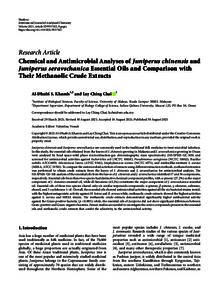Document
Chemical and antimicrobial analyses of juniperus chinensis and juniperus seravschanica essential oils and comparison with their methanolic crude extracts.
Identifier
DOI: 10.1155/2021/9937522
Source
International Journal of Analytical Chemistry. v. 2021, 9937522
Contributors
Chai, Lay Ching., Author
Country
United Kingdom.
City
London
Publisher
Hindawi Limited.
Gregorian
2021-01-01
Language
English
English abstract
Juniperus chinensis and Juniperus seravschanica are commonly used in the traditional folk medicine to treat microbial infection. In this study, the essential oils obtained from the leaves of J. chinensis growing in Malaysia and J. seravschanica growing in Oman were analysed by head space-solid phase microextraction-gas chromatography mass spectrometry (HS-SPME-GC-MS) and screened for antimicrobial activities against Escherichia coli (NCTC 10418), Pseudomonas aeruginosa (NCTC 10662), Bacillus subtilis ATCC6059, Micrococcus luteus (ATCC 9341), Staphylococcus aureus (NCTC 6571), and methicillin-resistant S. aureus (MRSA; ATCC 33591). To compare the antimicrobial activities of extracts using different extraction methods, methanol extraction was performed to obtain crude extracts from the leaves of J. chinensis and J. seravschanica for antimicrobial analysis. The HS-SPME-GS-MS analysis of the essential oils from the leaves of J. chinensis and J. seravschanica identified 37 and 36 components, respectively. Essential oils from these two species had distinctive chemical component profiles, with α-pinene (27.2%) as the major component of J. chinensis essential oil, while dl-limonene (45.2%) constitutes the major component of J. seravschanica essential oil. Essential oils of these two species shared only six similar terpenoids compounds: α-pinene, β-pinene, γ-elemene, sabinene, elemol, and 3-cyclohexen-1-ol. Overall, the essential oils showed antimicrobial activities against all the six bacterial strains tested, with the highest antagonistic activity against M. luteus and B. cereus; while, methanolic crude extracts showed the highest activities against S. aureus and MRSA strains. The methanolic crude extracts demonstrated significantly higher antibacterial activity against the Gram-positive bacteria (p0.005); while, the essential oils of Juniperus did not show significant differences between Gram-positive and Gram-negative bacteria. Future studies are needed to investigate the active compounds present in the essential oils and methanolic crude extracts that confer the selectivity in the antimicrobial activity.
ISSN
1687-8760
Resource URL
Category
Journal articles

